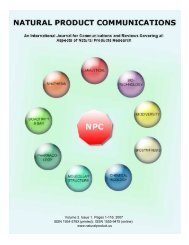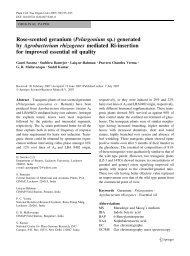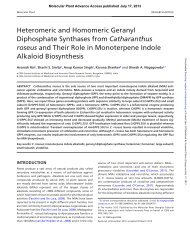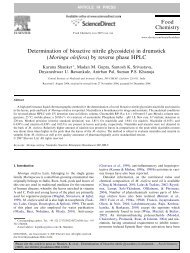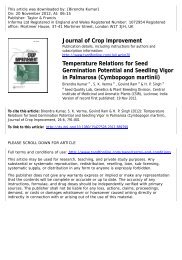Analysis of hairy root culture of Rauvolfia serpentina ... - CIMAP Staff
Analysis of hairy root culture of Rauvolfia serpentina ... - CIMAP Staff
Analysis of hairy root culture of Rauvolfia serpentina ... - CIMAP Staff
Create successful ePaper yourself
Turn your PDF publications into a flip-book with our unique Google optimized e-Paper software.
<strong>Analysis</strong> <strong>of</strong> <strong>hairy</strong> <strong>root</strong> <strong>culture</strong> <strong>of</strong> <strong>Rauvolfia</strong> <strong>serpentina</strong> ORIGINAL RESEARCH 597to screen and select the best performer amongst a wider,independently generated, heterogeneous background,as reported in earlier analogous studies (Christey andBraun, 2005). Chemical pr<strong>of</strong>iling <strong>of</strong> a large number <strong>of</strong>independently generated <strong>hairy</strong> <strong>root</strong> clones through theapplication <strong>of</strong> conventional complex solvent extractionprocess is undeniably a herculean task.In order to pr<strong>of</strong>ile the <strong>hairy</strong> <strong>root</strong> clones <strong>of</strong> <strong>Rauvolfia</strong><strong>serpentina</strong> quickly and with great accuracy for the characterization<strong>of</strong> the indole alkaloids expressed in them,we have utilized a new mass spectrometric ionizationtechnique, DART (direct analysis in real time). DARTis coupled to a time-<strong>of</strong>-flight mass analyzer that providesselectivity and accurate elemental composition assignmentthrough exact mass measurement. The DARTtechnique has been found to be extremely useful fordirect detection <strong>of</strong> chemicals on surfaces withoutrequiring sample preparation such as solvent extraction.In this communication, we report the identification<strong>of</strong> two alkaloids, vomilenine and reserpine, that wereexpressed in the <strong>hairy</strong> <strong>root</strong> <strong>culture</strong>s <strong>of</strong> R. <strong>serpentina</strong> bydirectly analyzing the <strong>hairy</strong> <strong>root</strong>s using the DARTspectrometric method. The structures <strong>of</strong> the two alkoidswere confirmed as vomilenine (1) and reserpine (2) byexact measurement <strong>of</strong> their molecular formulae. Tothe best <strong>of</strong> our knowledge, this is the first report <strong>of</strong>chemical pr<strong>of</strong>iling <strong>of</strong> the <strong>hairy</strong> <strong>root</strong>s <strong>of</strong> plant tissue<strong>culture</strong> origin using DART technique. Moreover, thisis also the first report <strong>of</strong> expression <strong>of</strong> reserpine in the<strong>hairy</strong> <strong>root</strong> <strong>culture</strong> <strong>of</strong> R. <strong>serpentina</strong>.EXPERIMENTALInduction and establishment <strong>of</strong> <strong>hairy</strong> <strong>root</strong>s. <strong>Rauvolfia</strong><strong>serpentina</strong> plants (8–10 weeks), maintained under in-vitroconditions on semisolid MS (Murashige and Skoog, 1962)medium supplemented with 2.0 mg/L 6-benzylaminopurine(BAP) and 0.1 mg/L α-naphthalene acetic acid (NAA), wereused as the explant source. The young leaves were inoculatedthrough pricking with a 48-h-old suspension <strong>culture</strong><strong>of</strong> A. rhizogenes strain A 4 (a kind gift from Pr<strong>of</strong>essor D.Tepfer, INRA, Versailles Cedex, France), grown in liquidYMB (Hooykass et al., 1977) medium (O.D. 600 = 0.9–1.0) andco-<strong>culture</strong>d on hormone-free, semi-solid MS medium. After48 h <strong>of</strong> co-cultivation with the bacterial strain, the explantswere transferred on to the same medium containing 1.0 g/L <strong>of</strong>Cephalaxin (Ranbaxy, India) under dark conditions. Similartypes <strong>of</strong> explants, pricked with a sterile needle devoid <strong>of</strong> thebacterial suspension, were <strong>culture</strong>d under uniform conditionsas controls. The emerging <strong>hairy</strong> <strong>root</strong>s were subsequentlytransferred to the half and full strengths <strong>of</strong> the MS mediumcontaining 3% (w/v) sucrose for their further proliferation.Once established, the individual <strong>hairy</strong> <strong>root</strong> clones were transferredto liquid MS medium with the same concentration<strong>of</strong> antibiotic and incubated on a rotary shaker in the dark at25 ± 1°C under constant agitation (80 rpm). The antibioticconcentration was progressively lowered and finally completelyomitted after 4 months. Roots excised from in-vitrogrown complete plantlets were <strong>culture</strong>d under identical conditionsin liquid MS medium supplemented with 1.0 mg/Lindole-3-butyric acid (IBA) to serve as control <strong>root</strong>s.Characterization <strong>of</strong> <strong>hairy</strong> <strong>root</strong>s. Polymerase chain reactionanalysis was carried out to prove the transformed nature <strong>of</strong>the independently generated <strong>hairy</strong> <strong>root</strong> clones following apublished procedure (Rahman et al., 2004).DART mass spectrometryThe mass spectrometer used was a JMS-100 TLC (AccuT<strong>of</strong>)atmospheric pressure ionization time-<strong>of</strong>-flight mass spectrometer(Jeol, Tokyo, Japan) fitted with a DART ion source.The mass spectrometer was operated in positive-ion modewith a resolving power <strong>of</strong> 6000 (full-width at half-maximum).The orifice 1 potential was set to 28 V, resulting in minimalfragmentation. The ring lens and orifice 2 potentials were setto 13 and 5 V, respectively. Orifice 1 was set to a temperature<strong>of</strong> 100°C. The RF ion guide potential was 300 V. Data acquisitionwas from m/z 10 to 1050. The DART ion source wasoperated with helium gas flowing at approximately 4 L/min.The gas heater was set to 300°C. The potential on the dischargeneedle electrode <strong>of</strong> the DART source was set to 3000 V, electrode1 to 100 V and the grid to 250 V. The sample (<strong>hairy</strong><strong>root</strong>) was positioned in the gap between the DART sourceand mass spectrometer for measurements. Exact mass calibrationwas accomplished by including a mass spectrum <strong>of</strong> neatpolyethylene glycol (1:1 mixture PEG 200 and PEG 600)in the data file. The mass calibration was accurate to within± 0.003 u. Using the Mass Center s<strong>of</strong>tware, the elementalcomposition could be determined on selected peaks.RESULTS AND DISCUSSIONEmergence <strong>of</strong> <strong>hairy</strong> <strong>root</strong>s could be seen after four weeks<strong>of</strong> bacterial inoculation <strong>of</strong> the leaf explants with the A.rhizogenes strain A 4 at 81.25% relative transformationfrequency. In accordance with an earlier report (Benjaminet al., 1993), most <strong>of</strong> the emerging <strong>root</strong>s <strong>of</strong> the presentstudy tend to form calli in the half-strength, hormonefree,liquid basal MS medium during further sub-culturing.However, on the basis <strong>of</strong> potential to grow without callusingalong with maximum elongation and branchingbehavior, one particular <strong>hairy</strong> <strong>root</strong> clone could be selectedfor further studies out <strong>of</strong> 30 independent <strong>hairy</strong><strong>root</strong> lines. The selected <strong>hairy</strong> <strong>root</strong> clone exhibited anRol-A-positive result, which indicated its transformednature. The biosynthetic potential <strong>of</strong> this particular<strong>hairy</strong> <strong>root</strong> clone has been evaluated through application<strong>of</strong> the newly developed DART technique.Mass spectrometry is a very important tool for thedetermination <strong>of</strong> molecular weight and structure determination<strong>of</strong> organic molecules. It has also been utilizedin the field <strong>of</strong> biotechnology as one <strong>of</strong> the core methodsfor characterization <strong>of</strong> different compounds. TheCopyright © 2008 John Wiley & Sons, Ltd. Biomed. Chromatogr. 22: 596–600 (2008)DOI: 10.1002/bmc




